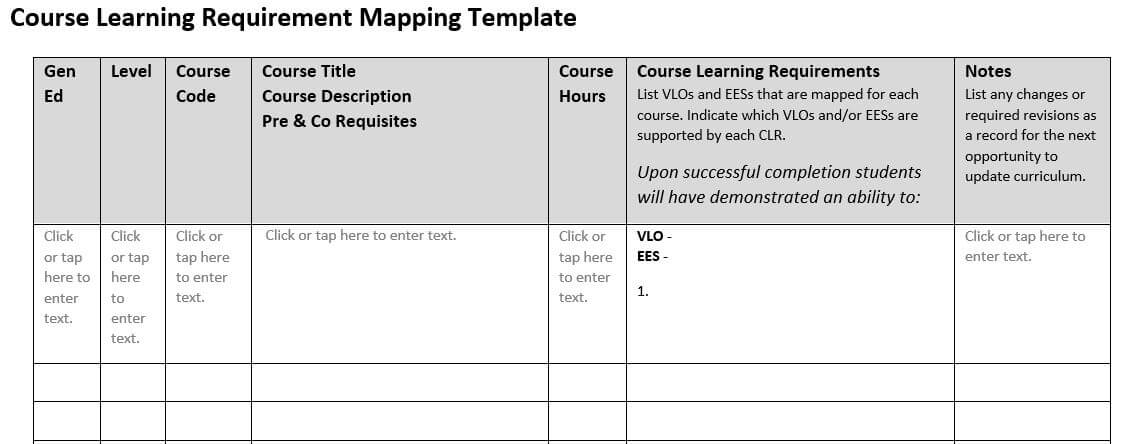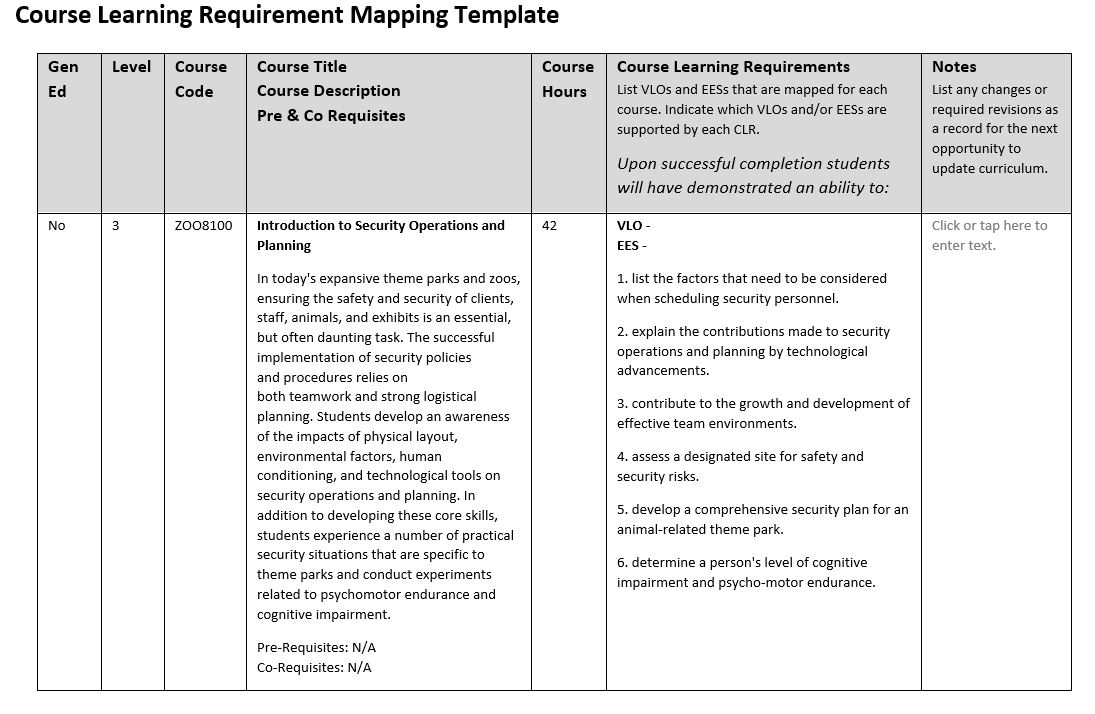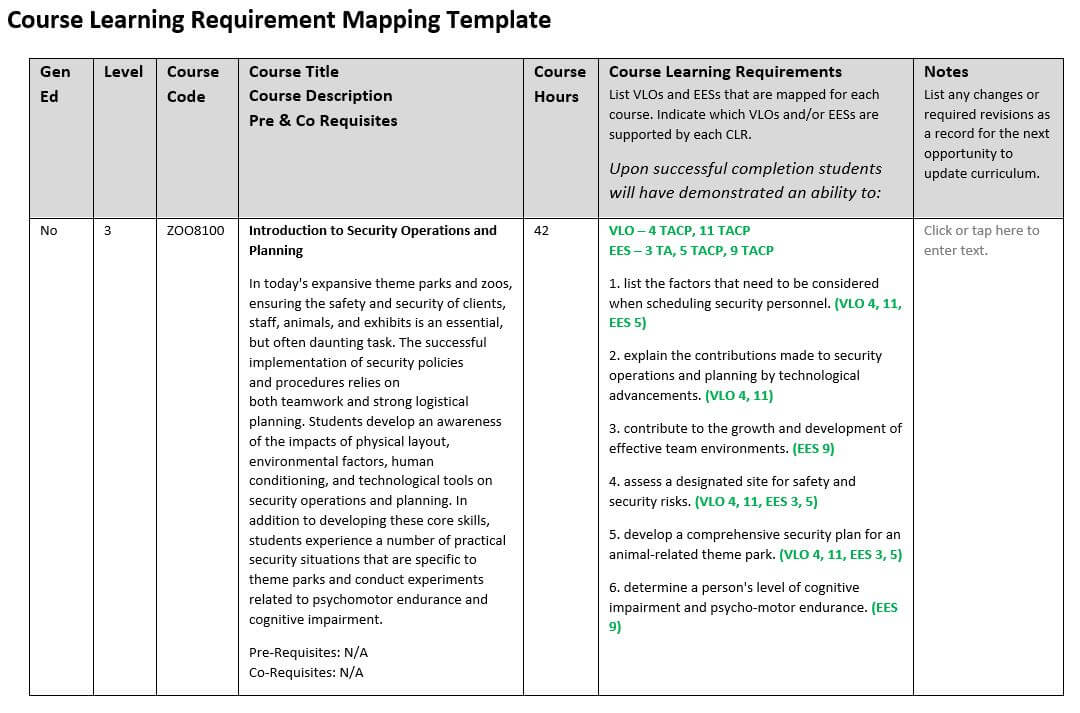Course Outcome Mapping
What is Course Outcome Mapping?
Each program has program outcome maps that indicate which courses support each program-level learning outcome including Vocational Learning Outcomes (VLOs) and Essential Employability Skills (EESs). For more details on program outcome mapping, see the Program Outcome Mapping resource.
The course-level learning outcomes—called Course Learning Requirements (CLRs) at Algonquin College—are mapped to the program-level learning outcomes (VLOs and EESs). This validates the program-level mapping and verifies that the course is contributing to the program-level learning outcomes in the way the program outcome maps indicate.
Mapping Course Outcomes
Step 1.
Locate the relevant course information:
- Level of the course within the program
- Course code
- Course title
- Course description
- Pre- and co-requisites
- Course hours
- Course Learning Requirements
- Indication if a course is a General Education course
Course information is stored in COMMS (Course Outline and Mapping Management System) which can be accessed with your College username and password. Use the following guide to locate relevant course information.
Guide – Locating Course Information in COMMS
Step 2.
Organize the course information within the Course Learning Requirement Mapping Template.

Step 3.
Locate the relevant Vocational Learning Outcome (VLO) and Essential Employability Skills (EES) maps.
Program curriculum maps are stored in COMMS (Course Outline and Mapping Management System) which can be accessed with your College username and password. Use the following guide to locate a program curriculum map.
Guide – Program Outcome Maps in COMMS
Step 4.
Select a course to map the Course Learning Requirements (CLRs) to the Vocational Learning Outcomes (VLOs) and the Essential Employability Skills (EES).
In the example below, the course ZOO8100 Introduction to Security Operations and Planning is selected.

Step 5.
Using the Vocational Learning Outcome (VLO) and the Essential Employability Skills maps, identify the VLOs and EESs to which the course is mapped.
In the example below, the course maps to VLO 4, 11 and EES 3, 5, 9.


Step 6.
List the Vocational Learning Outcomes (VLOs) and Essential Employability Skills (EES) the course supports in the template.

Step 7.
For each Vocational Learning Outcome (VLO) and Essential Employability Skill (EES) mapped to this course, identify which Course Learning Requirements (CLRs) support the development of all or a portion of the VLO.
In the example below, when reviewing VLO 4, CLRs 1, 2, 4 and 5 align. It is evident in the language of each of the CLRs that the course-level outcome is supporting the program-level VLO.

Step 8.
Document the identified alignment in the template.

Step 9.
Repeat the Course Learning Requirement (CLR) alignment (Steps 7-8) for each Vocational Learning Outcome (VLO) and Essential Employability Skill (EES) listed and document it in the template.
In the example below, the following alignment was identified:
- VLO 11 is supported by CLR 1, 2, 4, 5
- EES 3 is supported by CLR 4, 5
- EES 5 is supported by CLR 1, 4, 5
- EES 9 is supported by CLR 3, 6

Step 10.
Reflect on the Course Learning Requirement (CLR) to Vocational Learning Outcome (VLO) and Essential Employability Skills (EES) mapping.
- Are there any CLRs that do not align to an identified VLO/EES?
- It could be necessary to modify the program outcome map to add the VLO/EES that this CLR does support
- It could be necessary to remove the CLR from the course or to move it to another course
- It could be necessary to revise the CLR to make the alignment to the VLO/EES more evident
- Are there any identified VLOs/EESs that are not supported by any CLRs?
- It could be necessary to make a change to the program outcome map to remove this VLO/EES from this course mapping
- It could be necessary to revise existing CLRs to make their alignment to the VLO/EES more evident
- It could be necessary to write a new CLR to support the VLO/EES
Brief descriptions of required changes can be made in the Notes column of the template in order to maintain a record for the next opportunity to implement curriculum updates (see below for details on implementation of changes).

Implementing Changes Resulting from Mapping Course Outcomes
While mapping the Course Learning Requirements (CLRs), the need for changes to the program outcome maps (VLO or EES maps) or the CLRs may be identified. Required changes are implemented through the following processes:
- Program outcome maps – Programs submit any required updates to Vocational Learning Outcomes and Essential Employability Skills maps during the Annual Curriculum Review in the Fall. Along with proposed changes to the Program Narrative and Program of Study on the CAL9999 report, the Chair and Curriculum Administrator review and approve proposed changes to the program outcomes maps. Approved program outcomes maps appear by program in COMMS following the rollover that occurs in the Spring.
- Course Learning Requirements (CLRs) – revised CLRs are entered into COMMS by the Course Outline Writers (Spring).